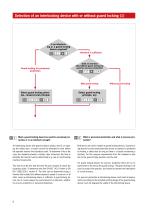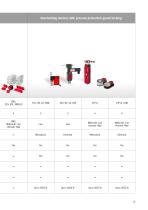 Website:
EUCHNER GmbH + Co. KG
Website:
EUCHNER GmbH + Co. KG
Catalog excerpts

The way through the standard Questions and answers on EN ISO 14119:2013 More than safety.
Open the catalog to page 1
Selection of an interlocking device with or without guard locking Must a guard locking device be used for personnel protection or is an interlock enough? 6 What is personnel protection and what is process protection? 6 Which conditions must a guard locking device meet for process protection according to EN ISO 14119? 7 How can it be ensured that the interlock is not degraded with a process protection guard locking device? 7 Which principles are there for guard locking? 7 Which guard locking principle must be selected? 7 How much force must a guard locking device have? 8 What is the purpose...
Open the catalog to page 2
Questions and answers on the standard EN ISO 14119:2013 Safety of machinery. Interlocking devices associated with guards. Principles for design and selection These guidelines provide an aid to the application of EN ISO 14119 in the form of a procedure for the selection of a suitable interlocking or guard locking device. However, the guidelines are no substitute for reading the standard, as the entire contents cannot be given. devices in a reasonably foreseeable manner” may be the same as in EN 1088, however the procedure is described in significantly more detail and more straightforwardly....
Open the catalog to page 3
»The way through the standard« Selection of an interlocking device with or without guard locking Is an interlocking or a guard locking device required? EN ISO 14119 Guard locking for personnel protection Shall an interlock with/without guard locking be used for process protection? EN ISO 14119 With guard locking Select guard locking principle, closed-circuit principle 4.3 + 5.7.1 Without guard locking Select guard locking principle, any EN ISO 14119 Determination of necessary locking force EN ISO 14119 Selection of supplementary releases 5.7.5 + 6.2.3 Selection of type of interlocking...
Open the catalog to page 4
Design measures Arrangement and fastening of position switch EN ISO 14119 Arrangement and fastening of actuator EN ISO 14119 Safety evaluation Determine Performance Level (PL) EN ISO 14119 Measures against tampering Basic measures against tampering EN ISO 14119 Is there a motivation to tamper? EN ISO 14119 Additional measures against tampering EN ISO 14119
Open the catalog to page 5
Selection of an interlocking device with or without guard locking (1) Is an interlocking or a guard locking device required? EN ISO 14119 Guard locking for personnel protection Shall an interlock with/without guard locking be used for process protection? EN ISO 14119 With guard locking Select guard locking principle, closed-circuit principle EN ISO 14119 Select guard locking principle, any Without guard locking Determination of necessary locking force EN ISO 14119 Must a guard releases locking device be used for personnel protection or is an interlock enough? EN ISO 14119 An interlocking...
Open the catalog to page 6
Which conditions must a guard locking device meet for process protection according to EN ISO 14119? In the “locked” position a prevention of inadvertent locking position ensures that the safety door is in the “closed” position. In relation to the guard locking device and the control of the guard locking, it must be ensured that the interlocking function (the monitoring of the position of the safety door) is not degraded. In addition all requirements on the interlock must be met. ► The first safety function of an interlock, whether with or without process protection guard locking, is the...
Open the catalog to page 7
With guard locking Without guard locking Selection of an interlocking device with or without guard locking (2) Select guard locking principle, closed-circuit principle EN ISO 14119 Select guard locking principle, any EN ISO 14119 Determination of necessary locking force EN ISO 14119 Selection of supplementary releases EN ISO 14119 Selection of type of interlocking device EN ISO 14119 How much force must a guard locking device have? Auxiliary release According to the standard the locking force FZh must be stated for Selection of level every guard locking device. coding very wide range of...
Open the catalog to page 8
Escape release Emergency release The emergency release, also not a safety function, is used to make it possible to reach the danger area in a machine quickly in an emergency. An example here is the outbreak of a fire in the system that must be extinguished quickly. In this case access without tools is possible. To reset the emergency release a tool or similar must be used. The closed-circuit current principle for guard locking solenoids can be used in almost all cases with an emergency release if rapid access to the machine from the exterior must be ensured. The usage of a release feature...
Open the catalog to page 9
Selection of supplementary Selection of an interlocking device with or without guard locking (3) releases EN ISO 14119 Selection of type of interlocking device EN ISO 14119 Selection of level of coding EN ISO 14119 Selection of safety switch EN ISO 14119 26 What is the purpose of division into types? The division is used in the standard to formulate different requirements on the various possible interlocking devices. The standard differentiates between four types: T ype 1 Uncoded mechanically actuated position switch Type 2 Coded mechanically actuated position switch Type 3 Uncoded...
Open the catalog to page 10
Which levels of coding are there and for what are they required? There are three levels of coding for actuators: L ow Up to 9 different actuators are available edium M 10 to 1000 different actuators are available igh H More than 1000 different actuators are available In the standard this information refers to the number of different actuators. Mechanical safety switches with separate actuator correspond to the low level of coding. Transponder-coded safety switches from EUCHNER are available with low and high coding. Multicode devices have low coding, conversely all unicode devices have high...
Open the catalog to page 11
Interlocking devices with process protection guard locking CMS, Multicode: Low Unicode: High Multicode: Low Unicode: High Multicode: Low Unicode: High
Open the catalog to page 13All EUCHNER GmbH + Co. KG catalogs and technical brochures
-
EUCHNER Safety Services
24 Pages
-
Electronic-Key-System EKS2
3 Pages
-
Product Guide
20 Pages
-
Electronic-Key-System EKS
60 Pages
-
Electronic-Key-System EKS
60 Pages
-
Industry 4.0
16 Pages
-
EKS with touch panel
12 Pages
-
News 2023
6 Pages
-
Safe key system CKS2
10 Pages
-
Enabling Switches ZS
92 Pages
-
About EUCHNER
34 Pages
-
Transponder-coded safety switches
160 Pages
-
MGBS
52 Pages
-
MGB2
80 Pages
-
Multifunctional Gate Box MGB
5 Pages
-
Multifunctional Gate Box
133 Pages
-
Product Overview Automation
8 Pages
-
Product Overview ManMachine
6 Pages
-
AC-DP-04-SA
2 Pages
-
Safety Switches with Plastic Housing
172 Pages
-
Safety switch CTP‑BI
2 Pages
-
Safety Switches with Metal Housing
220 Pages
-
EKS with USB port
2 Pages
-
Proven Systems - Proven Safe
6 Pages
-
Multiple Limit Switches
36 Pages
-
Position Switches
56 Pages
-
Safety switch CTP-Extended
2 Pages
-
Safety Switches NQ/TQ
6 Pages
-
Joystick Switches
28 Pages
-
EKS Light
8 Pages
-
Safety Relays ESM
32 Pages
-
Electronic-Key-System
24 Pages






























































